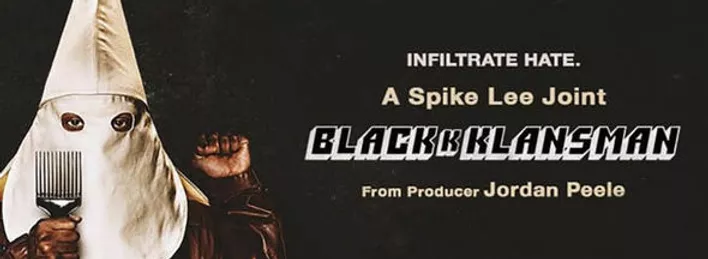BlacKkKlansman: A Must-See for American Studies’ students!

With the Oscar season approaching, this might be a good moment to look back at the films of the past year. For me, in this moment of reflection brings to mind one particular movie that struck me the most – BlacKkKlansman.
In the two times I saw this movie in the cinema (I enjoyed it so much, I went twice), BlacKkKlansman was able to do something I had never seen before. Both times, at the same point in the movie, the audience was dead silent. A quietness unprecedented in a full theatre. This silence was not merely the horror of the intense hatred of members of the Ku Klux Klan, it was the realization how persistent this hate is, even in the current age. An age in which the President of the United States notes that there was “blame on both sides.” I will not spoil the plot, as I think everyone who does American Studies should see this movie. However, I do want to bring your attention to several interesting aspects of this movie.
A drama with humor
The plot revolves around the first African-American police officer in Colorado Springs, Ron Stallworth, played by John David Washington, who manages to infiltrate the local chapter of Ku Klux Klan by posing as “white” on the phone. The unlikely story is based upon the 2014 memoir Black Klansman written by Ron Stallworth, and is both dramatic and humorous at the same time. The conversations Stallworth has on the phone with the Klan’s grand wizard David Duke, in which he uses all stereotypes and prejudices used by Klan members, are funny and poignant at the same time.
What works are the intriguing characters. The characterization of Stallworth by Washington makes a compelling protagonist, who does not take himself too seriously and navigates the difficulties he faces as first African-American cop both with humor, accent and dance moves, but also with a determination and idealism in regards to racism. He is supported by his Jewish colleague Flip Zimmerman, a strong role from Adam Driver, who acts as Stallworth in the actual meetings with the Colorado Springs Ku Klux Klan. Driver, for me most notable for his role as Kylo Ren in Star Wars, portrays Zimmerman as someone who at first seems fairly indifferent to the KKK and its actions, but becomes more and more engaged throughout the movie and his interactions with the Klan.
Spike Lee’s Rhetoric
While at first, the film’s tone is not necessarily dead serious, Klan members are almost caricatures and the interactions between Zimmerman and Stallworth with Klan members might make you smile, director Spike Lee very visibly has an agenda. Throughout the entire movie, the criticism on current behaviors is not subtle, as the rhetoric used by Duke is very recognizable, with slogans as “America First” and promises to make it “great again.”
At times, the music plays a vital role in anchoring what the intentions are. One of these moments is when Zimmerman and other members of the clan are practicing their firearms on targets. These targets are not seen during most of the scene, as the focus is on Zimmerman and his interaction with the Klan members. However, at the very end of the scene when the Klan and Zimmerman are gone, a heavy melody starts playing, and it appears the men had been shooting at silhouettes that can immediately be recognized as the way in which African-American runaway slaves used to be portrayed in the 1800s.
True Story?
Interestingly enough, for us American Studies students, Lee incorporates some actual footage and stories from American history. On the one hand, he uses the 1915 film Birth of a Nation as a prominent aspect of his movie. Perhaps some of you have encountered this movie in Americas II. The black-and-white silent movie (there is no spoken dialogue) is a three-hour glorification and celebration of the Ku Klux Klan. For me personally this was one of the weirdest and most confronting things I have ever seen, and the prominence of Birth of a Nation in BlacKkKlansman as a form of entertainment and enjoyment for the Klan members, who decades (the movie is set in the 1970s) later support its racist and dangerous message, is a striking move by director Spike Lee.
While the Ku Klux Klan watches Birth of a Nation, this scene is juxtaposed by a Black Power meeting where young African-Americans listen to the story of Civil Rights Movement activist, actor and former confidant of Martin Luther King Jr. Harry Belafonte, who plays a friend of Jesse Washington. Belafonte narrates the horrific (true) story of the lynching of Washington in 1916. The ways in which Lee weaves these historical segments from the early twentieth century together with Ron Stallworth’s memoires and contemporary problems with racism makes the movie highly relevant.
Reasons to watch BlacKkKlansman are its surprising story, its interesting characters and its powerful criticism while it is still an entertaining Hollywood movie. For these reasons, I will not be surprised if the film would win an Oscar. And why the cinema was so extremely quiet? That is something you should see for yourself.
